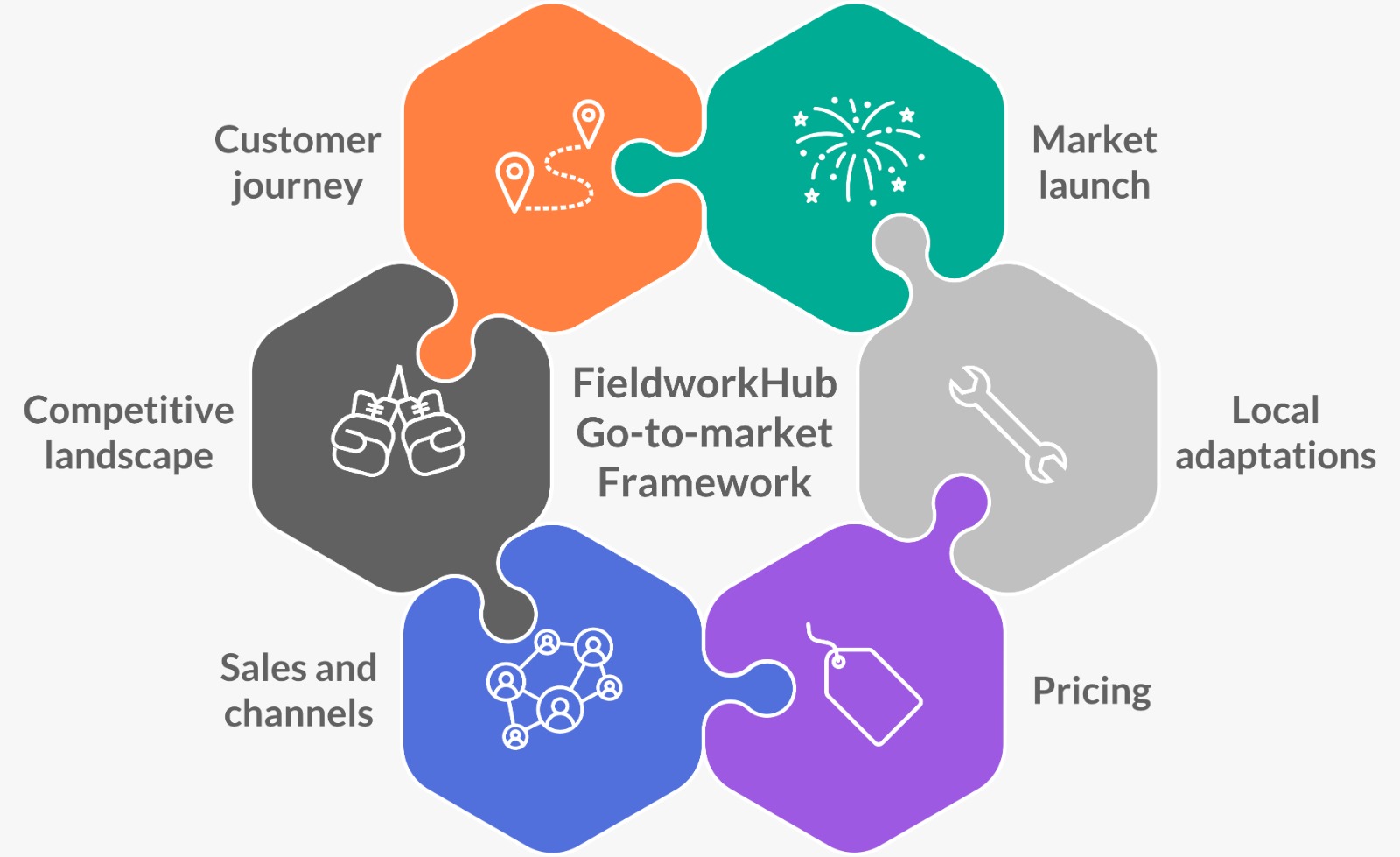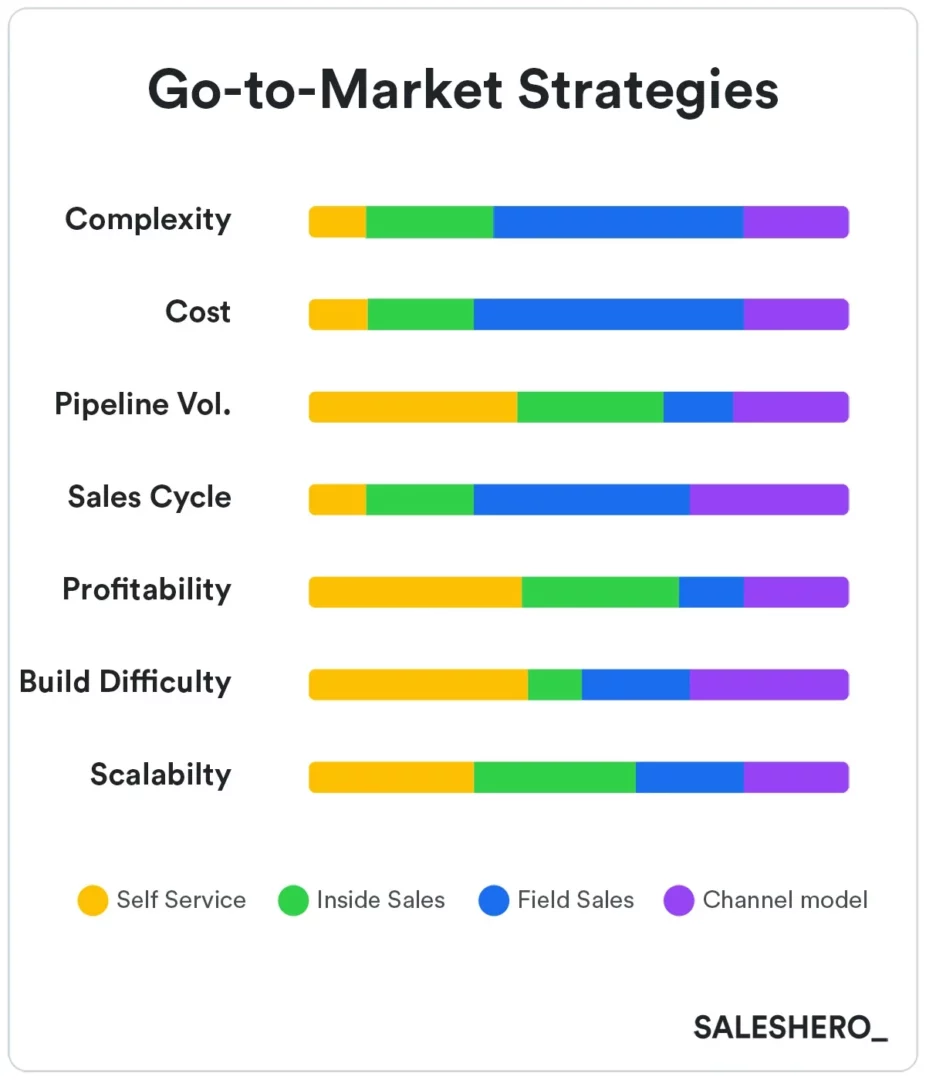When planning a new launch, understanding the market and having a solid plan before the release is crucial to the product’s success. Blindly releasing a new product to the market without research and planning can lead to failure.
Utilizing a go-to-market strategy is one way to make sure your launch is hitting the market at the right time. Before you can start planning your next release, your company will need to understand the basics of a go-to-market strategy, as well as begin creating one for your new products.
Keep reading, or use the following links to jump ahead:
- What Is a Go-to-market Strategy?
- 5 Components of a Successful B2B Go-to-Market Strategy
- Step-by-step Approach to Creating Your B2B Go-to-Market Strategy
- Tips for Creating a Winning GTM strategy for Startups and B2B SaaS Companies
What Is a Go-to-Market Strategy?

Simply put, a go-to-market (GTM) strategy is the plan your company creates as a step-by-step guide for a product launch. This will include understanding the target audience and collecting data, outlining marketing needs, and creating a sales plan.
Most importantly, a GTM helps identify a need within the market, so your product can be launched as the solution. A good GTM will use data to help drive the product launch decisions, including identifying the right audience and correct timeframe for the release.
A GTM can be used for physical products, as well as services, company restructures, or new businesses. This type of framework will help keep the end goal aligned across departments and ensure bases are covered for success.
New products take time, resources, and money to create. Having a GTM can make sure all of those efforts are being used to their fullest potential. A successful product launch aims to increase return on investment (ROI), and a GTM can be a powerful tool to make that happen.
Many companies have experienced product failures, which can usually be attributed to wrong timing, bad marketing, or poor market research. Outlining a launch strategy can take the guesswork out of a release, as well as prevent oversights or mistakes.
While there is always a chance of a product flop, regardless of planning, having a GTM can help manage expectations and prepare your company for the launch. This strategy can also help your team improve future roll-outs. With a framework in place, it’s easier to see which aspects of the release were successful and which areas need improvement.
There are two types of GTM strategies: flywheel and funnel. On the more traditional side, the funnel method focuses on generating leads and helping them through the sales cycle. The flywheel method engages prospects and customers through inbound marketing to build strong relationships.
5 Components of a Successful B2B Go-to-Market Strategy
Before your team hammers out the details for your GTM strategy, it is important to understand a few key components of a successful B2B go-to-market strategy. These details will help your marketing and sales team craft the GTM strategy while using data to back up their decisions.
Creating a solution to a market need. Before getting any further along, it’s important to take a look at your product and identify how it fits into the market. Understanding how your product solves a current need in the market will help drive its success when pitching to leads and current customers.
Identifying your target audience. It is crucial for your product to reach the right customers. Focusing on marketing to your target audience will help ensure quality leads are being nurtured and pushed through the sales funnel.
Understanding your competition. Knowing which other companies are offering similar products will help your team understand the demand and role your solution can play in the market. Market research will allow your team to make data-driven decisions to decide how your product will fit into the competitive landscape.
Demand for your product. Similar to understanding your competition, knowing the demand for your solution can help determine the success of your launch. It’s important to make sure the market isn’t oversaturated with similar options before releasing a new solution.
Planning the distribution. Getting your product to the masses is one of the last steps in a successful launch. Make sure your team has a plan, whether it’ll be through an app, third-party distributor, or a website purchase.
Step-by-Step Approach to Creating Your B2B Go-to-Market Strategy
Once your company understands the role a GTM plan will play in your product launch, it’s time to start creating the framework for your strategy.
Pinpoint the Problem
Before going any further, your team should focus on identifying the problem your product will solve. Understanding how your company is providing a solution in the current market will help guide your leads and customers to a purchase. The goal of your launch should be to address and solve a specific problem within the market.
Identify the Target Audience
Making sure the product information reaches the right audience is crucial for converting leads to sales. Starting off, your company can focus on determining who is experiencing the problem your product wants to solve.
Next, your team can start working on using an Ideal Customer Profile to define who would be the perfect customer for this product. This profile is made up of certain characteristics including demographics, geography, size, budget, and pain points. Understanding this information will help your marketing team tailor their messaging to attract quality leads that will translate to sales.
In a similar vein, understanding buyer personas will also help your team understand the best audience for your launch. Not all customers are the same, and it’s important to make sure quality leads aren’t getting skipped over. Buyer personas help your team differentiate between the unique customers your brand attracts.
Research Your Competitors
In many markets, including B2B, it’s important to know the companies that are selling similar products. Dig deeper into your competition to understand the audience they’re catering to, as well as the differences in your products. This information will help your team determine where your solution falls in the market.
Plan Your Messaging
Along with knowing your target audience, your marketing team will need to plan their outreach. Your team will need to segment audiences based on buyer personas to make sure the right information gets to each group. Making sure your efforts earn the highest ROI will boost the success of your launch.
Understand the Buyer’s Journey
Once you have a marketing plan in place, it’s time to map out the journey that your customers will take. This will help your team visualize the funnel your prospects go through while making a purchase. By having this information, your customer journey map can show any weaknesses or trouble spots in your sales journey, which allows your company to tighten up the process.
Create a Sales and Marketing Plan

Determine which channels are best for your release, and begin creating content. This can include social media, SEO content, and email content. Make sure your chosen channels are utilized by your target audience.
Creating a sales plan means deciding how your product will be sold. It’s important to identify this process, so your sales team is able to convert leads to purchases. Determine if your team will be using a self-service model, inside sales, or field sales.
Set Goals and Create Processes
Using a GTM strategy helps set expectations for a product launch. By setting key performance indicators (KPIs), as well as using SMART goals, your company can measure the success of a release.
Creating processes will help your team know how to achieve the goals that are being set. This will help sales and marketing work together for the best results and encourage collaboration across all departments.
Tips for Creating a Winning GTM strategy for Startups and B2B SaaS Companies
Once you have a GTM strategy in place, your team can begin planning a successful product release. There is no one-size-fits-all when it comes to creating a GTM, but following the lead from other companies can help push your business to the next level. Startups and B2B SaaS companies can both benefit from creating a GTM strategy for their product launches.
For B2B SaaS, growing the user base and engaging new prospects is typically the end goal of a product launch. By taking part in community-led growth, your company can increase users and have a successful product release. This strategy focuses on leveraging your community for acquiring new leads and overall expansion.
If your company is a growing start-up within the B2B industry, utilizing a Sales-Led growth strategy can help boost revenue. This tactic requires time and effort from your sales and marketing team, but it means relying heavily on your sales team as a push for higher numbers. If your teams are aligned properly with a strong hand-off process between leads, this strategy can help scale your business and create successful product launches.
Click here to start your lead generation cycle to create a target audience for your GTM strategy by using LeadBoxer’s free trial.
